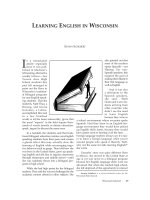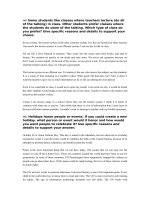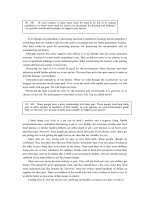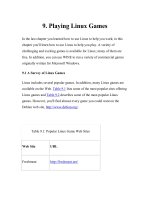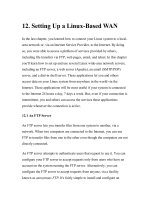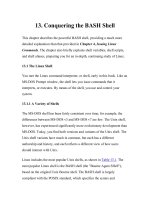Tài liệu Learning SPARQL potx
Bạn đang xem bản rút gọn của tài liệu. Xem và tải ngay bản đầy đủ của tài liệu tại đây (7.42 MB, 256 trang )
www.it-ebooks.info
www.it-ebooks.info
Learning SPARQL
www.it-ebooks.info
www.it-ebooks.info
Learning SPARQL
Querying and Updating with SPARQL 1.1
Bob DuCharme
Beijing
•
Cambridge
•
Farnham
•
Köln
•
Sebastopol
•
Tokyo
www.it-ebooks.info
Learning SPARQL
by Bob DuCharme
Copyright © 2011 Bob DuCharme. All rights reserved.
Printed in the United States of America.
Published by O’Reilly Media, Inc., 1005 Gravenstein Highway North, Sebastopol, CA 95472.
O’Reilly books may be purchased for educational, business, or sales promotional use. Online editions
are also available for most titles (). For more information, contact our
corporate/institutional sales department: (800) 998-9938 or
Editor: Simon St. Laurent
Production Editor: Jasmine Perez
Proofreader: Jasmine Perez
Indexer: Bob DuCharme
Cover Designer: Karen Montgomery
Interior Designer: David Futato
Illustrator: Robert Romano
Printing History:
July 2011: First Edition.
Portions of Chapter 7 were first published by IBM developerWorks in the article “Build Wikipedia query
forms with semantic technology.”
Nutshell Handbook, the Nutshell Handbook logo, and the O’Reilly logo are registered trademarks of
O’Reilly Media, Inc. Learning SPARQL, the image of the anglerfish, and related trade dress are trade-
marks of O’Reilly Media, Inc.
Many of the designations used by manufacturers and sellers to distinguish their products are claimed as
trademarks. Where those designations appear in this book, and O’Reilly Media, Inc. was aware of a
trademark claim, the designations have been printed in caps or initial caps.
While every precaution has been taken in the preparation of this book, the publisher and author assume
no responsibility for errors or omissions, or for damages resulting from the use of the information con-
tained herein.
ISBN: 978-1-449-30659-5
[LSI]
1310137130
www.it-ebooks.info
For my mom and dad, Linda and Bob Sr., who
always supported any ambitious projects I
attempted, even when I left college because my
bandmates and I thought we were going to become
big stars. (We didn’t.)
www.it-ebooks.info
www.it-ebooks.info
Table of Contents
Preface . . . . . . . . . . . . . . . . . . . . . . . . . . . . . . . . . . . . . . . . . . . . . . . . . . . . . . . . . . . . . . . . . . . . . xi
1. Jumping Right In: Some Data and Some Queries . . . . . . . . . . . . . . . . . . . . . . . . . . . . . 1
The Data to Query 2
Querying the Data 3
More Realistic Data and Matching on Multiple Triples 7
Searching for Strings 12
What Could Go Wrong? 13
Querying a Public Data Source 13
Summary 17
2. The Semantic Web, RDF, and Linked Data (and SPARQL) . . . . . . . . . . . . . . . . . . . . . . 19
What Exactly Is the “Semantic Web”? 19
URLs, URIs, IRIs, and Namespaces 21
The Resource Description Format (RDF) 24
Storing RDF in Files 24
Storing RDF in Databases 29
Data Typing 30
Making RDF More Readable with Language Tags and Labels 31
Blank Nodes and Why They’re Useful 33
Named Graphs 35
Reusing and Creating Vocabularies: RDF Schema and OWL 35
Linked Data 41
SPARQL’s Past, Present, and Future 42
The SPARQL Specifications 43
Summary 44
3. SPARQL Queries: A Deeper Dive . . . . . . . . . . . . . . . . . . . . . . . . . . . . . . . . . . . . . . . . . . . 45
More Readable Query Results 46
Using the Labels Provided by DBpedia 48
Getting Labels from Schemas and Ontologies 51
vii
www.it-ebooks.info
Data That Might Not Be There 53
Finding Data That Doesn’t Meet Certain Conditions 57
Searching Further in the Data 59
Searching with Blank Nodes 66
Eliminating Redundant Output 67
Combining Different Search Conditions 70
FILTERing Data Based on Conditions 73
Retrieving a Specific Number of Results 76
Querying Named Graphs 78
Queries in Your Queries 85
Combining Values and Assigning Values to Variables 86
Sorting, Aggregating, Finding the Biggest and Smallest and 88
Sorting Data 89
Finding the Smallest, the Biggest, the Count, the Average 91
Grouping Data and Finding Aggregate Values within Groups 93
Querying a Remote SPARQL Service 95
Federated Queries: Searching Multiple Datasets with One Query 98
Summary 100
4. Copying, Creating, and Converting Data (and Finding Bad Data) . . . . . . . . . . . . . . 103
Query Forms: SELECT, DESCRIBE, ASK, and CONSTRUCT 104
Copying Data 105
Creating New Data 109
Converting Data 114
Finding Bad Data 117
Defining Rules with SPARQL 118
Generating Data About Broken Rules 121
Using Existing SPARQL Rules Vocabularies 125
Asking for a Description of a Resource 127
Summary 128
5.
Datatypes and Functions . . . . . . . . . . . . . . . . . . . . . . . . . . . . . . . . . . . . . . . . . . . . . . . 129
Datatypes and Queries 129
Representing Strings 134
Comparing Values and Doing Arithmetic 136
Functions 139
Program Logic Functions 140
Node Type and Datatype Checking Functions 144
Node Type Conversion Functions 146
Datatype Conversion 151
Checking, Adding, and Removing Spoken Language Tags 157
String Functions 164
Numeric Functions 168
viii | Table of Contents
www.it-ebooks.info
Date and Time Functions 170
Hash Functions 172
Extension Functions 175
Summary 176
6. Updating Data with SPARQL . . . . . . . . . . . . . . . . . . . . . . . . . . . . . . . . . . . . . . . . . . . . 177
Getting Started with Fuseki 178
Adding Data to a Dataset 180
Deleting Data 186
Changing Existing Data 188
Named Graphs 193
Dropping Graphs 196
Named Graph Syntax Shortcuts: WITH and USING 198
Deleting and Replacing Triples in Named Graphs 200
Summary 205
7. Building Applications with SPARQL: A Brief Tour . . . . . . . . . . . . . . . . . . . . . . . . . . . 207
SPARQL and Web Application Development 208
SPARQL Query Results XML Format 217
SPARQL Processors 221
Standalone Processors 221
Triplestore SPARQL Support 221
Middleware SPARQL Support 222
Public Endpoints, Private Endpoints 224
Summary 224
Glossary . . . . . . . . . . . . . . . . . . . . . . . . . . . . . . . . . . . . . . . . . . . . . . . . . . . . . . . . . . . . . . . . . . . 225
Index . . . . . . . . . . . . . . . . . . . . . . . . . . . . . . . . . . . . . . . . . . . . . . . . . . . . . . . . . . . . . . . . . . . . . 231
Table of Contents | ix
www.it-ebooks.info
www.it-ebooks.info
Preface
It is hardly surprising that the science they turned to for
an explanation of things was divination, the science
that revealed connections between words and things,
proper names and the deductions that could be
drawn from them
—Henri-Jean Martin,
The History and Power of Writing
Why Learn SPARQL?
More and more people are using the query language SPARQL (pronounced “sparkle”)
to pull data from a growing collection of public and private data. Whether this data is
part of a semantic web project or an integration of two inventory databases on different
platforms behind the same firewall, SPARQL is making it easier to access it. In the
words of W3C Director and Web inventor Tim Berners-Lee, “Trying to use the
Semantic Web without SPARQL is like trying to use a relational database without
SQL.”
SPARQL was not designed to query relational data, but to query data conforming to
the RDF data model. RDF-based data formats have not yet achieved the mainstream
status that XML and relational databases have, but an increasing number of IT pro-
fessionals are discovering that tools using the RDF data model let them expose diverse
sets of data (including, as we’ll see, relational databases) with a common, standardized
interface. Both open source and commercial software have become available with
SPARQL support, so you don’t need to learn new programming language APIs to take
advantage of these data sources. This data and tool availability has led to SPARQL
letting people access a wide variety of public data and providing easier integration of
data silos within an enterprise.
Although this book’s table of contents, glossary, and index let it serve as a reference
guide when you want to look up the syntax of common SPARQL tasks, it’s not a
complete reference guide—if it covered every corner case that might happen when you
use strange combinations of different keywords, it would be a much longer book.
xi
www.it-ebooks.info
Instead, the book’s primary goal is to quickly get you comfortable using SPARQL to
retrieve and update data and to make the best use of the retrieved data. Once you can
do this, you can take advantage of the extensive choice of tools and application libraries
that use this query language to retrieve, update, and mix and match the huge amount
of RDF-accessible data out there.
1.1 Alert
The W3C made SPARQL 1.0 a Recommendation, or official standard, in January 2008.
The language and implementations matured quickly, and as of this writing, SPARQL
1.1 (along with updated implementations) is nearly ready. This version adds new fea-
tures to SPARQL, such as new functions to call, greater control over variables, and the
ability to update data. This book’s discussions of new 1.1 features will be highlighted
with “1.1 Alert” boxes like this. The free software described in this book lets you try
all of the new features.
Organization of This Book
Chapter 1, Jumping Right In: Some Data and Some Queries
Writing and running a few simple queries before getting into more detail on the
background and use of SPARQL.
Chapter 2, The Semantic Web, RDF, and Linked Data (and SPARQL)
The bigger picture: the semantic web, related specifications, and what SPARQL
adds to and gets out of them.
Chapter 3, SPARQL Queries: A Deeper Dive
Building on Chapter 1, a broader introduction to the query language.
Chapter 4, Copying, Creating, and Converting Data (and Finding Bad Data)
Using SPARQL to copy data from a dataset, to create new data, and to find bad
data.
Chapter 5, Datatypes and Functions
How datatype metadata, standardized functions, and extension functions can con-
tribute to your queries.
Chapter 6, Updating Data with SPARQL
Using SPARQL’s update facility to add to and change data in a dataset instead of
just retrieving it.
Chapter 7, Building Applications with SPARQL: A Brief Tour
How you can incorporate SPARQL queries into web-based applications.
Glossary
A glossary of terms and acronyms used when discussing SPARQL and the semantic
web.
xii | Preface
www.it-ebooks.info
You’ll also find an index at the back of the book to help you quickly locate explanations
for SPARQL and RDF keywords and concepts.
Conventions Used in This Book
The following typographical conventions are used in this book:
Italic
Indicates new terms, URLs, email addresses, filenames, and file extensions.
Constant width
Used for program listings, as well as within paragraphs to refer to program elements
such as variable or function names, databases, data types, environment variables,
statements, and keywords.
Constant width bold
Shows commands or other text that should be typed literally by the user.
Constant width italic
Shows text that should be replaced with user-supplied values or by values deter-
mined by context.
Documentation Conventions
Variables and prefixed names are written in a monospace font like this. (If you don’t
know what prefixed names are, you’ll learn in Chapter 2.) Sample data, queries, code,
and markup are also shown in this font. Sometimes these include bolded text to high-
light important parts that the surrounding discussion refers to, like the quoted string
in the following:
# filename: ex001.rq
PREFIX d: <
SELECT ?person
WHERE
{ ?person d:homeTel "(229) 276-5135" . }
When including punctuation at end of a quoted phrase, I put it inside the quotation
marks in the American publishing style, “like this,” unless the quoted string represents
a specific value that would be changed if it included the punctuation. For example, if
your password on a system is “swordfish”, I don’t want you to think that the comma
is part of the password.
The following icons alert you to details that are worth a little extra attention:
An important point that might be easy to miss or a tip that can make
your development or your queries more efficient.
Preface | xiii
www.it-ebooks.info
A tip that can make your development or your queries more efficient.
A warning about a common problem or an easy trap to fall into.
Using Code Examples
This book is here to help you get your job done. In general, you may use the code in
this book in your programs and documentation. You do not need to contact us for
permission unless you’re reproducing a significant portion of the code. For example,
writing a program that uses several chunks of code from this book does not require
permission. Selling or distributing a CD-ROM of examples from O’Reilly books does
require permission. Answering a question by citing this book and quoting example
code does not require permission. Incorporating a significant amount of example code
from this book into your product’s documentation does require permission.
We appreciate, but do not require, attribution. An attribution usually includes the title,
author, publisher, and ISBN. For example: “Learning SPARQL by Bob DuCharme
(O’Reilly). Copyright 2011 Bob DuCharme, 978-1-449-30659-5.”
If you feel your use of code examples falls outside fair use or the permission given above,
feel free to contact us at
You’ll also find a zip file of all of this book’s sample code and data files at http://www
.learningsparql.com, along with links to free SPARQL software and other resources.
Safari® Books Online
Safari Books Online is an on-demand digital library that lets you easily
search over 7,500 technology and creative reference books and videos to
find the answers you need quickly.
With a subscription, you can read any page and watch any video from our library online.
Read books on your cell phone and mobile devices. Access new titles before they are
available for print, and get exclusive access to manuscripts in development and post
feedback for the authors. Copy and paste code samples, organize your favorites, down-
load chapters, bookmark key sections, create notes, print out pages, and benefit from
tons of other time-saving features.
O’Reilly Media has uploaded this book to the Safari Books Online service. To have full
digital access to this book and others on similar topics from O’Reilly and other pub-
lishers, sign up for free at .
xiv | Preface
www.it-ebooks.info
How to Contact Us
Please address comments and questions concerning this book to the publisher:
O’Reilly Media, Inc.
1005 Gravenstein Highway North
Sebastopol, CA 95472
800-998-9938 (in the United States or Canada)
707-829-0515 (international or local)
707-829-0104 (fax)
We have a web page for this book, where we list errata, examples, and any additional
information. You can access this page at:
/>To comment or ask technical questions about this book, send email to:
For more information about our books, courses, conferences, and news, see our website
at .
Find us on Facebook: />Follow us on Twitter: />Watch us on YouTube: />Acknowledgments
For their excellent contributions to the great improvements made to this book in the
last two months, I’d like to thank the book’s technical reviewers (Dean Allemang, Andy
Seaborne, and Paul Gearon) and sample audience reviewers (Priscilla Walmsley, Eric
Rochester, Peter DuCharme, and David Germano).
For helping me to get to know SPARQL well, I’d like to thank my colleagues at
TopQuadrant: Irene Polikoff, Robert Coyne, Ralph Hodgson, Jeremy Carroll, Holger
Knublauch, Scott Henninger, and the aforementioned Dean Allemang.
I’d also like to thank Dave Reynolds and Lee Feigenbaum for straightening out some
of the knottier parts of SPARQL for me, and O’Reilly’s Simon St. Laurent, Sarah
Schneider, Sanders Kleinfeld, and Jasmine Perez for helping me turn this into an actual
book.
Mostly, I’d like to thank my wife Jennifer and my daughters Madeline and Alice for
putting up with me as I researched and wrote and tested and rewrote and rewrote this.
Preface | xv
www.it-ebooks.info
www.it-ebooks.info
CHAPTER 1
Jumping Right In: Some Data
and Some Queries
Chapter 2 provides some background on RDF, the semantic web, and where SPARQL
fits in, but before going into that, let’s start with a bit of hands-on experience writing
and running SPARQL queries to keep the background part from looking too theoretical.
But first, what is SPARQL? The name is a recursive acronym for SPARQL Protocol and
RDF Query Language, which is described by a set of specifications from the W3C.
The W3C, or World Wide Web Consortium, is the same standards body
responsible for HTML, XML, and CSS.
As you can tell from the “RQL” part of its name, SPARQL is designed to query RDF,
but you’re not limited to querying data stored in one of the RDF formats. Commercial
and open source utilities are available to treat relational data, XML, spreadsheets, and
other formats as RDF so that you can issue SPARQL queries against these data sources
—or against combinations of these sources, which is one of the most powerful aspects
of the SPARQL/RDF combination.
The “Protocol” part of SPARQL’s name refers to the rules for how a client program
and a SPARQL processing server exchange SPARQL queries and results. These rules
are specified in a separate document from the query specification document and are
mostly an issue for SPARQL processor developers. You can go far with the query lan-
guage without worrying about the protocol, so this book doesn’t go into any detail
about it.
1
www.it-ebooks.info
The Data to Query
Chapter 2 describes more about RDF and all the things that people do with it, but to
summarize: RDF isn’t a data format, but a data model with a choice of syntaxes for
storing data files. In this data model, you express facts with three-part statements
known as triples. Each triple is like a little sentence that states a fact. We call the three
parts of the triple the subject, predicate, and object, but you can think of them as the
identifier of the thing being described (the “resource”; RDF stands for “Resource
Description Format”), a property name, and a property value:
subject (resource identifier) predicate (property name) object (property value)
richard homeTel (229) 276-5135
cindy email
The ex002.ttl file below has some triples expressed using the Turtle RDF format. (We’ll
learn about Turtle and other formats in Chapter 2.) This file stores address book data
using triples that make statements such as “richard’s homeTel value is (229) 276-5135”
and “cindy’s email value is ” RDF has no problem with assigning
multiple values for a given property to a given resource, as you can see in this file, which
shows that Craig has two email addresses:
# filename: ex002.ttl
@prefix ab: < .
ab:richard ab:homeTel "(229) 276-5135" .
ab:richard ab:email "" .
ab:cindy ab:homeTel "(245) 646-5488" .
ab:cindy ab:email "" .
ab:craig ab:homeTel "(194) 966-1505" .
ab:craig ab:email "" .
ab:craig ab:email "" .
Like a sentence written in English, Turtle (and SPARQL) triples usually end with a
period. The spaces you see before the periods above are not necessary, but are a com-
mon practice to make the data easier to read. As we’ll see when we learn about the use
of semicolons and commas to write more concise datasets, an extra space is often added
before each of these as well.
Comments in Turtle data and SPARQL queries begin with the hash
(#) symbol. Each query and sample data file in this book begins with a
comment showing the file’s name so that you can easily find it in the zip
file of the book’s sample data.
2 | Chapter 1: Jumping Right In: Some Data and Some Queries
www.it-ebooks.info
The first nonblank line of the data above, after the comment about the filename, is also
a triple ending with a period. It tells us that the prefix “ab” will stand in for the URI
just as an XML document might tell us with
the attribute setting xmlns:ab=" An RDF
triple’s subject and predicate must each belong to a particular namespace in order to
prevent confusion between similar names if we ever combine this data with other data,
so we represent them with URIs. Prefixes save you the trouble of writing out the full
namespace URIs over and over.
A URI is a Uniform Resource Identifier. URLs (Uniform Resource Locators), also
known as web addresses, are one kind of URI. A locator helps you find something, like
a web page (for example, and an
identifier identifies something. So, for example, the unique identifier for Richard in my
address book database is A URI may
look like a URL, and there may actually be a web page at that address, but there might
not be; its primary job is to provide a unique name for something, not to tell you about
a web page where you can send your browser.
Querying the Data
A SPARQL query typically says “I want these pieces of information from the subset of
the data that meets these conditions.” You describe the conditions with triple pat-
terns, which are similar to RDF triples but may include variables to add flexibility in
how they match against the data. Our first queries will have simple triple patterns, and
we’ll build from there to more complex ones.
The ex003.rq file below has our first SPARQL query, which we’ll run against the
ex002.ttl address book data shown above.
The SPARQL Query Language specification recommends that files stor-
ing SPARQL queries have an extension of .rq, in lowercase.
The following query has a single triple pattern, shown in bold, to indicate the subset
of the data we want. This triple pattern ends with a period, like a Turtle triple, and has
a subject of ab:craig, a predicate of ab:email, and a variable in the object position.
A variable is like a powerful wildcard. In addition to telling the query engine that triples
with any value at all in that position are OK to match this triple pattern, the values that
show up there get stored in the ?craigEmail variable so that we can use them elsewhere
in the query:
# filename: ex003.rq
PREFIX ab: <
Querying the Data | 3
www.it-ebooks.info
SELECT ?craigEmail
WHERE
{ ab:craig ab:email ?craigEmail . }
This particular query is doing this to ask for any ab:email values associated with the
resource ab:craig. In plain English, it’s asking for any email addresses associated with
Craig.
Spelling SPARQL query keywords such as PREFIX, SELECT, and
WHERE in uppercase is only a convention. You may spell them in
lower- or mixed case.
In a set of data triples or query triple patterns, the period after the last
one is optional, so the single triple pattern above doesn’t really need it.
Including it is a good habit, though, because adding new triple patterns
after it will be simpler. In this book’s examples, you will occasionally
see a single triple pattern between curly braces with no period at the end.
As illustrated in Figure 1-1, a SPARQL query’s WHERE clause says “pull this data out
of the dataset,” and the SELECT part names which parts of that pulled data you actually
want to see.
Figure 1-1. WHERE specifies data to pull out; SELECT picks which data to display
What information does the query above select from the triples that match its single
triple pattern? Anything that got assigned to the ?craigEmail variable.
4 | Chapter 1: Jumping Right In: Some Data and Some Queries
www.it-ebooks.info
As with any programming or query language, a variable name should
give a clue about the variable’s purpose. Instead of calling this varia-
ble ?craigEmail, I could have called it ?zxzwzyx, but that would make it
more difficult for human readers to understand the query.
A variety of SPARQL processors are available for running queries against data both
locally and remotely. (You will hear the terms SPARQL processor and SPARQL
engine, but they mean the same thing: a program that can apply a SPARQL query against
a set of data and let you know the result.) For queries against a data file on your own
hard disk, the free, Java-based program ARQ makes it pretty simple. (You can down-
load ARQ from />ARQ includes a batch file and a shell script that both let you run the ex003.rq query
against the ex002.ttl data with the following command at your shell prompt or Win-
dows command line:
arq data ex002.ttl query ex003.rq
ARQ’s default output format shows the name of each selected variable across the top
and lines drawn around each variable’s results using the hyphen, equals, and pipe
symbols:
| craigEmail |
================================
| "" |
| "" |
The following revision of the ex003.rq query uses full URIs to express the subject and
predicate of the query’s single triple pattern instead of prefixed names. It’s essentially
the same query, and gets the same answer from ARQ:
# filename: ex006.rq
SELECT ?craigEmail
WHERE
{
<
<
?craigEmail .
}
The differences between this query and the first one demonstrate two things:
• You don’t need to use prefixes in your query, but they can make the query more
compact and easier to read than one using full URIs. When you do use a full URI,
enclose it in angle brackets to show the processor that it’s a URI.
• White space doesn’t affect SPARQL syntax. The new query has carriage returns
between the three parts of the triple pattern, and it still works just fine.
Querying the Data | 5
www.it-ebooks.info
The formatting of this book’s query examples follow the conventions in
the SPARQL specification, which aren’t particularly consistent anyway.
In general, important keywords such as SELECT and WHERE go on a
new line. A pair of curly braces and their contents are written on a single
line if they fit there (typically, if the contents consist of a single triple
pattern, like in the ex003.rq query) and are otherwise broken out with
each curly brace on its own line, like in example ex006.rq.
The ARQ command above specified the data to query on the command line. SPARQL’s
FROM keyword lets you specify the dataset to query as part of the query itself. If you
omitted the data ex002.ttl parameter shown in that ARQ command line and used
this next query, you’d get the same result, because the FROM keyword names the
ex002.ttl data source right in the query:
# filename: ex007.rq
PREFIX ab: <
SELECT ?craigEmail FROM <ex002.ttl>
WHERE
{ ab:craig ab:email ?craigEmail . }
(The angle brackets around “ex002.ttl” tell the SPARQL processor to treat it as a URI.
Because it’s just a filename and not a full URI, ARQ assumes that it’s a file in the same
directory as the query itself.)
If you specify one dataset to query in the query itself with the FROM
keyword and another when you actually call the SPARQL processor (or,
as the SPARQL query specification says, “in a SPARQL protocol re-
quest”), the one specified in the protocol request overrides the one
specified in the query.
The queries we’ve seen so far had a variable in the triple pattern’s object position (the
third position) but you can put them in any or all of the three positions. For example,
let’s say someone called my phone from the number (229) 276-5135 and I didn’t
answer. I want to know who tried to call me, so I create the following query for my
address book database, putting a variable in the subject position instead of the object
position:
# filename: ex008.rq
PREFIX ab: <
SELECT ?person
WHERE
{ ?person ab:homeTel "(229) 276-5135" . }
When I have ARQ run this query against the ex002.ttl address book data, it gives me
this response:
6 | Chapter 1: Jumping Right In: Some Data and Some Queries
www.it-ebooks.info
| person |
==============
| ab:richard |
Triple patterns in queries often have more than one variable. For example, I could list
everything in my address book about Cindy with the following query, which has
a ?propertyName variable in the predicate position of its one triple pattern:
# filename: ex010.rq
PREFIX ab: <
SELECT ?propertyName ?propertyValue
WHERE
{ ab:cindy ?propertyName ?propertyValue . }
The query’s SELECT clause asks for values of the ?propertyName and ?propertyValue
variables, and ARQ shows them as a table with a column for each one:
| propertyName | propertyValue |
=====================================
| ab:email | "" |
| ab:homeTel | "(245) 646-5488" |
Out of habit from writing relational database queries, experienced
SQL users might put commas between variable names in the SELECT
part of their SPARQL queries, but this will cause an error.
More Realistic Data and Matching on Multiple Triples
In most RDF data, the subjects of the triples won’t be names that are so understandable
to the human eye, like the ex002.ttl dataset’s ab:richard and ab:cindy resource names.
They’re more likely to be identifiers assigned by some process, similar to the values a
relational database assigns to a table’s unique ID field. Instead of storing someone’s
name as part of the subject URI, as our first set of sample data did, more typical RDF
triples would have subject values that make no human-readable sense outside of their
important role as unique identifiers. First and last name values would then be stored
using separate triples, just like the homeTel and email values were stored in the sample
dataset.
Another unrealistic detail of ex002.ttl is the way that resource identifiers like
ab:richard and property names like ab:homeTel come from the same namespace—in
this case, the namespace that the ab: prefix
represents. A vocabulary of property names typically has its own namespace to make
it easier to use it with other sets of data.
More Realistic Data and Matching on Multiple Triples | 7
www.it-ebooks.info

